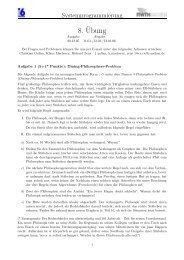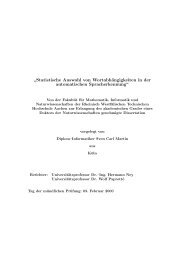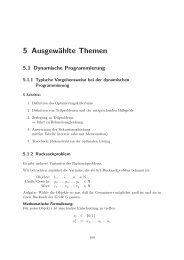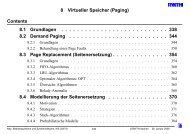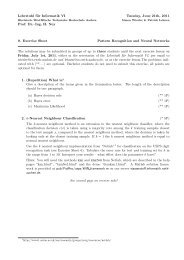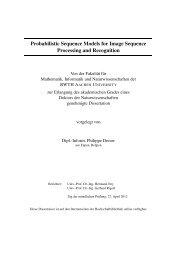n o h Y - Www I6 Informatik Rwth Aachen - RWTH Aachen University
n o h Y - Www I6 Informatik Rwth Aachen - RWTH Aachen University
n o h Y - Www I6 Informatik Rwth Aachen - RWTH Aachen University
Create successful ePaper yourself
Turn your PDF publications into a flip-book with our unique Google optimized e-Paper software.
81012trigrams, each of them with its own probability. This<br />
large number cannot be estimated from today’s training sets of<br />
up to one billion words. Thus, most probabilities will be estimated<br />
by Eq. (2) as zero, which is not desired and, by the chain<br />
rule Eq. (1), estimates the whole test set as zero if such a trigram<br />
appears in it. This is known as the sparse data or zero frequency<br />
problem.<br />
To counteract this problem, smoothing methods are applied.<br />
With smoothing,<br />
p(wjh)=(1)N(h;w)<br />
probability mass is discounted from the trigrams<br />
observed in the training set<br />
N(h)+ (wjh)<br />
and redistributed over the remaining<br />
(unseen) trigrams according to a more robust probability<br />
distribution(wjh)based on a simplified word historyh. In<br />
case of the trigram model, the bigram probability distribution is<br />
used as(wjh). A simple smoothing method is linear discounting [4] with<br />
the<br />
p(wjh)=8>:(1)N(h;w) N(h);<br />
two variants interpolation<br />
(wjh)<br />
or backing–off: N(h;w)>0,<br />
p(wjh)=max0;N(h;w)d<br />
Pw0:N(h;w0)=0(w0jh);otherwise<br />
N(h) +dn+(h) N(h) (wjh)<br />
Since the most reliably estimated (i.e. the most frequent) events (h;w)are distracted most by using linear discounting, an alternative<br />
called absolute discounting was proposed in [10] and<br />
tested in [11]. Using interpolation, this approach results in:<br />
withn+(h)as the number distinct events(h;w)observed in<br />
the training set. Absolute discounting can also be used with<br />
backing–off.<br />
Both the interpolation parameter and the discounting value<br />
dwould be estimated as zero on the training set because, by definition,<br />
the are no unobserved events in the training set. A method<br />
called leaving–one–out, a special case of cross–validation, is<br />
used for that task [10]: each position in the training set is visited,<br />
the event at that position dropped and the probability for that<br />
event estimated on the remainingN1events. Thus, events observed<br />
once in the training set (singletons) become unobserved.<br />
Closed–form solutions exist for both andd. It is even possible<br />
to derive a bigram statistics based on singleton events for<br />
the probability distribution(wjh)[7], called singleton back–<br />
off (BO) function.<br />
Tables 3 and 4 show the effect of the presented smoothing<br />
methods on the NAB and Verbmobil corpora, respectively. Interpolation<br />
is superior to backing–off in most cases, absolute to<br />
linear discounting in all cases. Using the singleton back–off<br />
function further improves the results. Compared to linear discounting<br />
with interpolation as the basic method of smoothing,<br />
a reduction in perplexity of up to 21% and in word error rate<br />
of up to 9% (relative) is achieved by using absolute discounting<br />
in connection with singleton back–off. This smoothing method<br />
will be used throughout the rest of this paper.<br />
3. WORD PHRASES<br />
Some word pairs appear to be closely connected to each other so<br />
that they should be treated as one word. E. g. the city name “New<br />
York” consists of two words, though it is one notion. Thus, the<br />
trigram (“New”, “York”,w) is, in effect, just a bigram. Using<br />
word phrases, we try to find such word pairs and add them to<br />
the vocabulary. Word phrases for language modeling were first<br />
proposed by [4] and used quite often thereafter. The most recent<br />
investigation was performed by [5].<br />
Table 3: Test set perplexities and word error rates for smoothing<br />
methods, NAB corpus.<br />
PP<br />
DEV set<br />
word errs. [%]<br />
del/ins WER<br />
PP<br />
EVL set<br />
word errs. [%]<br />
del/ins WER<br />
lin. disc.:<br />
backing–off 144.7<br />
interpolation 148.8<br />
1.7/2.6 13.9<br />
1.5/3.1 14.1<br />
150.4<br />
156.5<br />
1.8/3.0 14.8<br />
1.5/3.4 14.8<br />
abs. disc.:<br />
backing–off 125.8<br />
interpolation 132.0<br />
1.7/2.4 13.3<br />
1.5/2.7 13.4<br />
127.6<br />
135.4<br />
1.9/2.5 13.5<br />
1.6/2.9 13.8<br />
abs. disc.,<br />
singleton–BO:<br />
backing–off 122.9<br />
interpolation 121.8<br />
1.8/2.0 13.1<br />
1.8/2.0 12.8<br />
123.7<br />
123.4<br />
2.1/2.3 13.6<br />
2.0/2.3 13.6<br />
Table 4: Test set perplexities and word error rates for smoothing<br />
methods, Verbmobil corpus.<br />
PP word errs. [%]<br />
del/ins WER<br />
linear discounting:<br />
backing–off 52.4 3.9/3.4 19.6<br />
interpolation<br />
absolute discounting:<br />
48.2 3.3/4.1 18.9<br />
backing–off 43.8 3.5/3.2 18.8<br />
interpolation 41.9 3.3/3.2 17.9<br />
absolute discounting,<br />
singleton–BO:<br />
backing–off 43.9 3.6/3.0 18.3<br />
interpolation 40.6 3.3/3.1 17.7<br />
F=XwN(w)logN(w) N :<br />
~N(c):=N(a;b) ~N(b):=N(b)N(a;b)<br />
(3)<br />
w6=a;b;c:~N(w):=N(w) ~N:=NN(a;b)<br />
=~F(a;b)F =~N(a)log~N(a)+~N(b)log~N(b)+~N(c)log~N(c) F(a;b) ~Nlog~N N(a)logN(a)N(b)logN(b)+NlogN:<br />
The word pairs are selected by optimizing a unigram–based<br />
log–likelihood criterion:<br />
~N(a):=N(a)N(a;b)<br />
Once a new wordcis formed by joining two words(a;b), we<br />
get new counts<br />
and with these new counts a new unigram log–likelihood~F(a;b)<br />
from Eq. (3). Then the difference in unigram–log–likelihood is:<br />
We also tried a bigram criterion and a unigram criterion based on<br />
leaving–one–out, without much improvement. Further, it does<br />
not make much difference if we apply the criterion once for all<br />
word pairs (flat selection) or if we include the newly formed<br />
wordscinto the selection, thus obtaining phrases based on word<br />
triples or even more words (hierarchical selection). Another<br />
property of phrases is that there is no unique mapping from the




